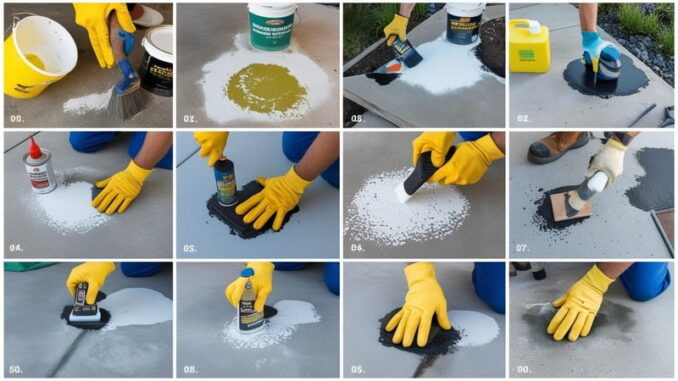Introduction
Removing paint from concrete can feel like a daunting task, but with the right tools, techniques, and a bit of patience, you can restore your concrete surfaces to their original look.
Whether you’re dealing with a splattered garage floor, a painted patio, or a stained driveway, this guide will walk you through the process of how to remove paint from concrete effectively.
We’ll cover everything from simple household solutions to heavy-duty methods, ensuring you have all the information you need to tackle the job.
Why Paint on Concrete Can Be Tricky

Concrete is a porous material, meaning it absorbs liquids like paint deep into its surface. This makes paint removal more challenging than on non-porous surfaces like glass or metal. The type of paint—oil-based, latex, or epoxy—also affects how difficult it will be to remove. For instance, oil-based paints tend to bond more stubbornly to concrete than water-based latex paints. Additionally, older paint or multiple layers can complicate the process.
According to a 2023 survey by the National Association of Home Builders, 68% of homeowners have tackled DIY home improvement projects, including paint removal, to save money. However, without the right approach, you risk damaging the concrete or wasting time on ineffective methods. Let’s dive into the best ways to remove paint from concrete, starting with preparation.
Preparing to Remove Paint From Concrete
Before you begin, proper preparation is key to a successful paint removal project. Taking the time to gather supplies and set up your workspace will save you headaches later.
What You’ll Need
- Protective gear: Safety goggles, gloves, and a mask to shield yourself from chemicals and dust.
- Cleaning supplies: Broom, dustpan, and a pressure washer (optional) for surface cleaning.
- Paint removal tools: Paint scraper, wire brush, or a putty knife for manual removal.
- Chemical strippers: Paint stripper (choose one safe for concrete), mineral spirits, or acetone.
- Absorbent materials: Cat litter, sawdust, or baking soda to soak up spills.
- Cleaning solutions: Dish soap, warm water, and a scrub brush for post-removal cleanup.
- Power tools (optional): Angle grinder or sandblaster for tough jobs.
Step-by-Step Preparation
- Clear the area: Remove furniture, vehicles, or other items from the concrete surface.
- Sweep thoroughly: Use a broom to remove dirt, debris, and loose paint flakes.
- Test the paint type: Dab a small area with rubbing alcohol. If the paint softens, it’s likely latex. If not, it could be oil-based or epoxy.
- Ventilate the space: Open windows and doors, especially if using chemical strippers, to avoid inhaling fumes.
- Protect nearby surfaces: Cover plants, walls, or other areas with plastic sheeting to prevent damage.
By setting up properly, you’ll make the process of removing paint from concrete safer and more efficient.
Method 1: Removing Paint From Concrete With Soap and Water
If the paint is fresh or water-based (latex), you may be able to remove it with simple household items. This method is eco-friendly and budget-friendly, making it a great starting point.
How It Works
Soap and water work best for recent spills or latex paint, which is less resistant to moisture. The soap breaks down the paint’s bond with the concrete, allowing you to scrub it away.
Steps to Follow
- Mix a solution of warm water and mild dish soap in a bucket.
- Pour the solution over the painted area and let it sit for 10–15 minutes.
- Use a stiff-bristled brush to scrub the paint vigorously.
- Rinse the area with clean water, using a hose or pressure washer for larger surfaces.
- Repeat if necessary, focusing on stubborn spots.
Tips for Success
- Act quickly if the paint is fresh, as dried paint is harder to remove.
- For small areas, use a sponge instead of a brush for better control.
- If the paint doesn’t budge, move on to a stronger method.
This method is ideal for minor paint spills, but for older or oil-based paints, you’ll need a more robust approach.
Method 2: Using Chemical Paint Strippers
Chemical paint strippers are highly effective for removing paint from concrete, especially for oil-based or epoxy paints. These products dissolve the paint, making it easier to scrape off.
Choosing the Right Stripper
Look for a paint stripper labeled as safe for masonry or concrete. Popular options include soy-based strippers, which are less toxic, or methylene chloride-based strippers for faster results. Always read the manufacturer’s instructions and test the product on a small area first.
How to Use a Chemical Stripper
- Apply the stripper: Use a paintbrush to spread a thick layer over the painted concrete.
- Let it sit: Allow the stripper to work for the recommended time (usually 15–30 minutes).
- Scrape the paint: Use a paint scraper or wire brush to lift the softened paint.
- Clean the residue: Wash the area with soap and water or a neutralizing solution (check the stripper’s label).
- Dispose of waste safely: Collect paint residue in a sealed container and follow local disposal regulations.
Safety Precautions
- Wear protective gear to avoid skin or eye contact with the stripper.
- Work in a well-ventilated area to minimize fume inhalation.
- Keep pets and children away from the work zone.
Chemical strippers are a go-to solution for stubborn paint, but they require careful handling to avoid health risks.
Method 3: Mechanical Methods for Paint Removal
For thick layers of paint or when chemical strippers aren’t enough, mechanical methods like grinding or sandblasting can get the job done. These approaches are more labor-intensive but highly effective.
Option 1: Grinding
An angle grinder with a diamond wheel can remove paint by physically grinding it off the concrete surface.
Steps
- Attach a diamond grinding wheel to your angle grinder.
- Work in small sections, applying light pressure to avoid gouging the concrete.
- Vacuum or sweep away dust as you go to keep the area clean.
- Finish by washing the concrete with soap and water.
Pros and Cons
- Pros: Fast and effective for large areas.
- Cons: Creates a lot of dust and requires skill to avoid damaging the concrete.
Option 2: Sandblasting
Sandblasting uses high-pressure sand or other abrasive materials to strip paint from concrete.
Steps
- Rent a sandblaster from a home improvement store.
- Set up a containment area with tarps to trap debris.
- Blast the painted surface in a sweeping motion, keeping the nozzle 6–12 inches away.
- Clean the area thoroughly to remove sand and paint particles.
Pros and Cons
- Pros: Works well for textured or uneven surfaces.
- Cons: Expensive and messy, requiring specialized equipment.
Mechanical methods are best for large-scale projects or when other methods fail, but they demand caution to prevent surface damage.
Method 4: Eco-Friendly Alternatives
If you prefer environmentally friendly solutions, there are ways to remove paint from concrete without harsh chemicals or heavy machinery.
Option 1: Baking Soda Blasting
Similar to sandblasting, baking soda blasting uses sodium bicarbonate to strip paint. It’s gentler on the concrete and biodegradable.
How It Works
A blasting unit propels baking soda particles at the paint, breaking it apart without damaging the concrete. You can rent equipment or hire a professional for this method.
Option 2: Vinegar and Heat
Vinegar can soften latex paint, especially when combined with heat.
Steps
- Heat white vinegar until warm (not boiling).
- Apply it to the paint with a cloth or sponge.
- Let it sit for 15 minutes, then scrub with a wire brush.
- Rinse with water and repeat if needed.
Eco-friendly methods are slower but ideal for small projects or environmentally conscious homeowners.
Common Mistakes to Avoid
When removing paint from concrete, certain missteps can waste time or damage your surface. Here’s what to watch out for:
- Using the wrong stripper: Always match the stripper to the paint type (latex, oil-based, or epoxy).
- Skipping protective gear: Chemicals and dust can harm your health without proper precautions.
- Over-grinding: Applying too much pressure with a grinder can leave scars on the concrete.
- Ignoring cleanup: Leftover paint residue can stain or attract dirt if not properly removed.
Post-Removal Cleanup and Maintenance
Once the paint is gone, cleaning and maintaining the concrete will keep it looking fresh.
Cleaning the Surface
- Wash the concrete with a mixture of water and mild detergent.
- Use a pressure washer for large areas to remove any remaining residue.
- Allow the surface to dry completely before applying sealants or new paint.
Sealing the Concrete
Applying a concrete sealer can protect the surface from future stains and make cleanup easier. Choose a penetrating sealer for outdoor surfaces or a topical sealer for indoor areas like garages.
Regular Maintenance
- Sweep regularly to prevent dirt buildup.
- Address spills immediately to avoid staining.
- Reapply sealer every 1–3 years, depending on foot traffic and weather exposure.
When to Call a Professional
While DIY methods are cost-effective, some situations call for professional help. Consider hiring an expert if:
- The painted area is very large (e.g., an entire driveway).
- The paint is extremely old or contains lead (common in homes built before 1978).
- You lack the time, tools, or confidence to do it safely.
Professionals have access to industrial-grade equipment and can ensure a flawless finish, though costs can range from $1–$5 per square foot, depending on the job’s complexity.
Conclusion
Removing paint from concrete doesn’t have to be overwhelming. By choosing the right method—whether it’s soap and water, chemical strippers, mechanical tools, or eco-friendly alternatives—you can restore your concrete surfaces with ease.
Start with the simplest approach and work your way up to more intensive methods as needed. With proper preparation, safety precautions, and a little elbow grease, you’ll have a clean, paint-free concrete surface in no time.
Whether you’re sprucing up your home for a sale or just refreshing your space, knowing how to remove paint from concrete is a valuable skill. So grab your tools, follow these steps, and enjoy the satisfaction of a job well done!






More Stories
How To Style A Coffee Table For Every Home
How to Decorate Your Home for Christmas Like a Pro
15 Easy Steps to Build a DIY Pergola: A Complete Homeowner’s Guide